Pizza Ovens Web participates in various affiliate programs, which means we may get paid commissions on certain products purchased through links in our blog.
Why Is My Pizza Dough Sticky? (7 Easy Ways to Fix It)
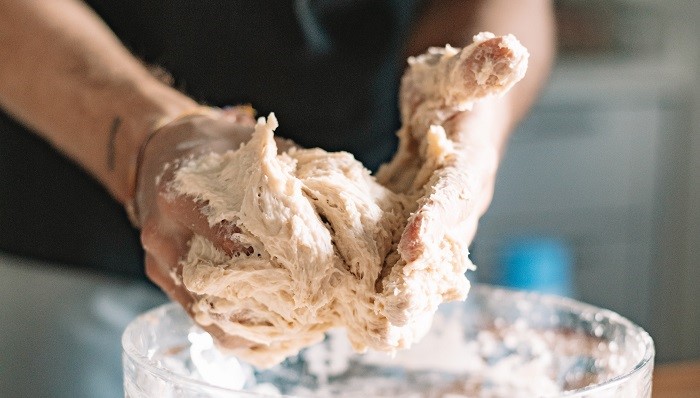
Sticky dough is a very common and irritating problem that people face when making pizza at home. But don’t let yourself feel like a newbie, even professional pizza chefs face sticky dough once in a while.
Most of the reasons for sticky dough are caused when people don’t work right with dough.
But don’t worry, that’s completely fixable, and if you read until the end, the possibility of you facing sticky dough again will be extremely low.
The other group of reasons mainly refers to the raw materials you’re using. Those won’t necessarily be fixable, but I will walk you through the steps to avoid those mistakes in the future.
The stickiness of the dough also depends on the stage it is currently at. In every different stage, there are different reasons for it.
Now, let’s walk through the 7 MOST common reasons for sticky dough, and how to easily fix each one of them.
Table of Contents
1. Oil your hands before working with the dough
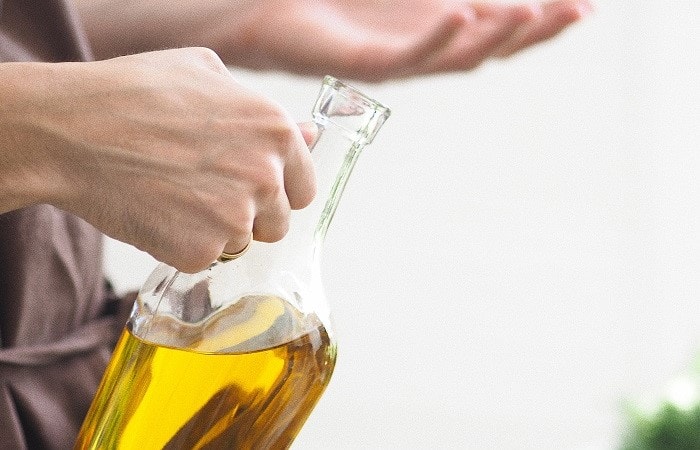
This one is the most common mistake I see people do when working with dough:
they mix all the ingredients, drop the dough on the counter and start working on it.
If you are using a low hydration recipe, you probably didn’t face any problem.
But, If you are making medium to high hydration dough you will probably feel the dough sticking to your hands like glue.
So, what did you miss?
Well, that happens when you work your dough with dry or wet hands, the dough will naturally stick to them.
To fix that, all you need to do is make sure your hands are clean and dry, and then oil them with a little bit of extra virgin olive oil.
Your oiled hands will prevent the dough from sticking to them, similar to the way oil resists water.
2. Use the "stretch and fold" technique
The stretch and fold technique is a crucial step for getting a smooth texture for your dough before forming your dough balls.
This technique is used at the end of the kneading and ensures that your top of the dough will be smooth, while the sticky part will stay inside and as a result, won’t bother you.
The process also helps your dough to accumulate air, which boosts gluten development.
“Stretch and fold” is a bit hard to explain so I’ll add a visual example.
The process should be performed like this:
1. Grab the dough by its sides on one of the edges.
2. Then slightly stretch the dough upwards without ripping it.
3. Then fold the dough onto itself (the negative side of where you pulled it from)
4. Rotate it left/right and repeat the process.
5. Make sure the downside always faces the same way.
3. Let your dough rest
The quality and strength of your gluten will determine how smooth your dough will be. The weaker it will be, the stickier the dough is.
High-quality gluten is created under the existence of two main components: good kneading, and proper resting.
The kneading is the first step that is meant to get your dough all together in one chunk.
When performed properly, the dough should be in one piece after about 15 minutes of kneading, which means the gluten has started to perform.
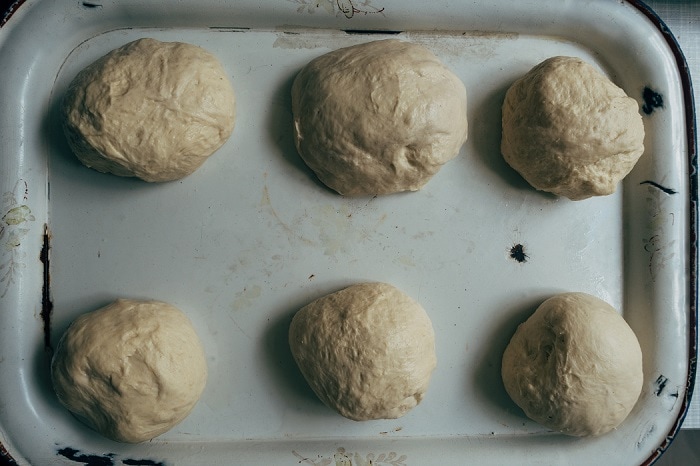
What if the dough is still sticky?
If it’s still a bit sticky, that means that your gluten isn’t strong enough, BUT it doesn’t necessarily mean you did something wrong.
At this point, all you need to do is just let the dough rest for 15-20 minutes. That is going to let your gluten build strength and make your dough much less sticky.
4. go for flour that is rich in protein 12-14%
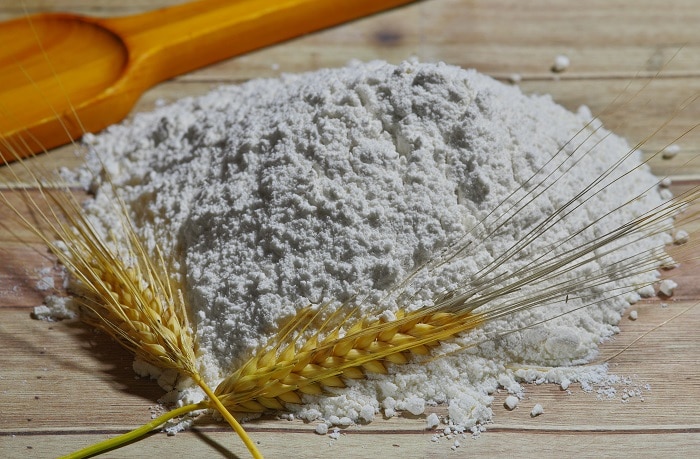
Another common mistake – people don’t pay attention to the amount of protein that’s in their flour and use all-purpose types.
The protein content is an important indicator of how much water the flour is capable to absorb.
People sometimes buy low-protein flours and try to make high hydration dough. In those cases, the flour won’t be able to absorb all the water, and the dough will come out sticky no matter how well you work it.
How to avoid this problem:
The first-aid approach to this problem will be to add more flour. It should make your dough smoother.
In the future, I recommend that you aim for 12-14% protein flours, they are the best suit for making pizzas, and should easily handle any hydration level.
5. Try lowering the hydration
Hydration directly affects how sticky your dough will be.
What does hydration even mean?
The hydration of your dough represents the amount of water in the dough as a percentage of the amount of flour. For example, if your dough contains 500 grams of water and 1000 grams of flour, you have a 50% hydration dough.
Generally, the higher the hydration is, the stickier your dough will be, and as a result, it will be harder to work with.
What hydration levels are best for YOU?
If you are just starting out, and don’t have much experience, I would suggest you aim for lower hydration levels.
When you’ll have more experience and feel more confident, you could go for higher hydration levels.
The quality of the flour you are using also affects the hydration levels you should work with.
If you are using quality flour like the blue or red Caputo, 60% should be perfect for you.
To avoid advanced and hard to work with hydrations, I recommend you stay under 65% hydration at the beginning.
6. learn to knead the dough properly
It is VERY important to correctly knead the dough, and if you are facing sticky dough, wrong kneading might be the reason.
Kneading is the main process where gluten develops.
Why is gluten even important?
Gluten can be described as a “glue” that holds the dough together and gives it an elastic and strong texture. When the quality of the gluten is high, the dough will be strong and smooth and shouldn’t be sticky.
So how do you properly develop it?
When it comes to gluten development, two main things build it – time and proper kneading.
Kneading can be performed in two ways, by hand or in a mixer.
If you are using a mixer and facing this problem, make sure you are using it right and you have a dough hook.
If you are working the dough by hand:
1. Fold the dough inside and press forwards
2. Make sure you fold only inside and don’t flip the dough.
3. Don’t work it too hard into the table.
4. Don’t rip the dough while kneading.
You can check this video to understand the process better.
7. your dough got over fermented
Over fermentation often happens when people don’t pay attention to the flour they are using, or if the dough proofs in hot places.
Every flour is made slightly different, and each one is made for different fermentation durations.
Sometimes people try to go for long proofing dough, while they don’t realize they are using short proofing flour. In these cases, the gluten will end up losing its structure and the dough will be sticky and really hard to work with.
Now when your dough is impossible to work with, you are probably thinking it should go in the trash, right?
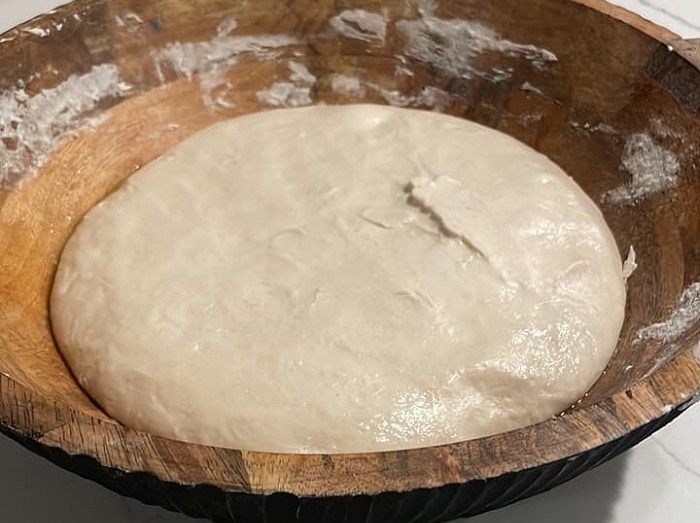
So here’s how you fix it:
Take a stainless steel pan and season it with a generous amount of olive oil.
Then season your dough with some semolina on both sides.
Now put the dough in the pan and try shaping it as the size of the pan. Don’t worry about it ripping apart, you can just fill out the gaps with excess dough, and it will make absolutely no difference!
Now add the sauce and cheese onto the dough and it’s ready to in the oven.
The cooking time depends on your preference, in a pizza oven, it should take you about 2 minutes, but the bottom won’t cook as well as usual (because the dough isn’t directly cooked on the stone).
If you like a crispy bottom, you can leave the pizza for an extra minute or two with flames turned off. It will give your bottom a nice golden and crispy texture.
Should sticky dough always concern you?
The short answer Is NO.
In general, sticky dough is sometimes just a part of the process.
If you’re working with high hydrations you will naturally face stickier dough and you don’t need to worry about it.
But even when you are making a 70% dough, when is stickiness just a part of the process?
The first normal situation you might face a sticky dough is after you add all the ingredients and start kneading the dough. If you properly work the dough, it should be much smoother.
The second normal situation your dough might be sticky is after the kneading. You might have done it all right, but your dough still doesn’t feel smooth enough, well you aren’t wrong, but it’s totally natural.
If the dough is still sticky after the kneading, it might need a rest to strengthen up the gluten.
Just let it rest for 20 minutes, That should make it much smoother.
So if you did all of those right but still face too sticky dough, I highly recommend you to go through the 7 reasons above and find out which one of them might be your problem.
Summing up, I hope you found this article helpful, and if you have any further questions feel free to get in touch with us.